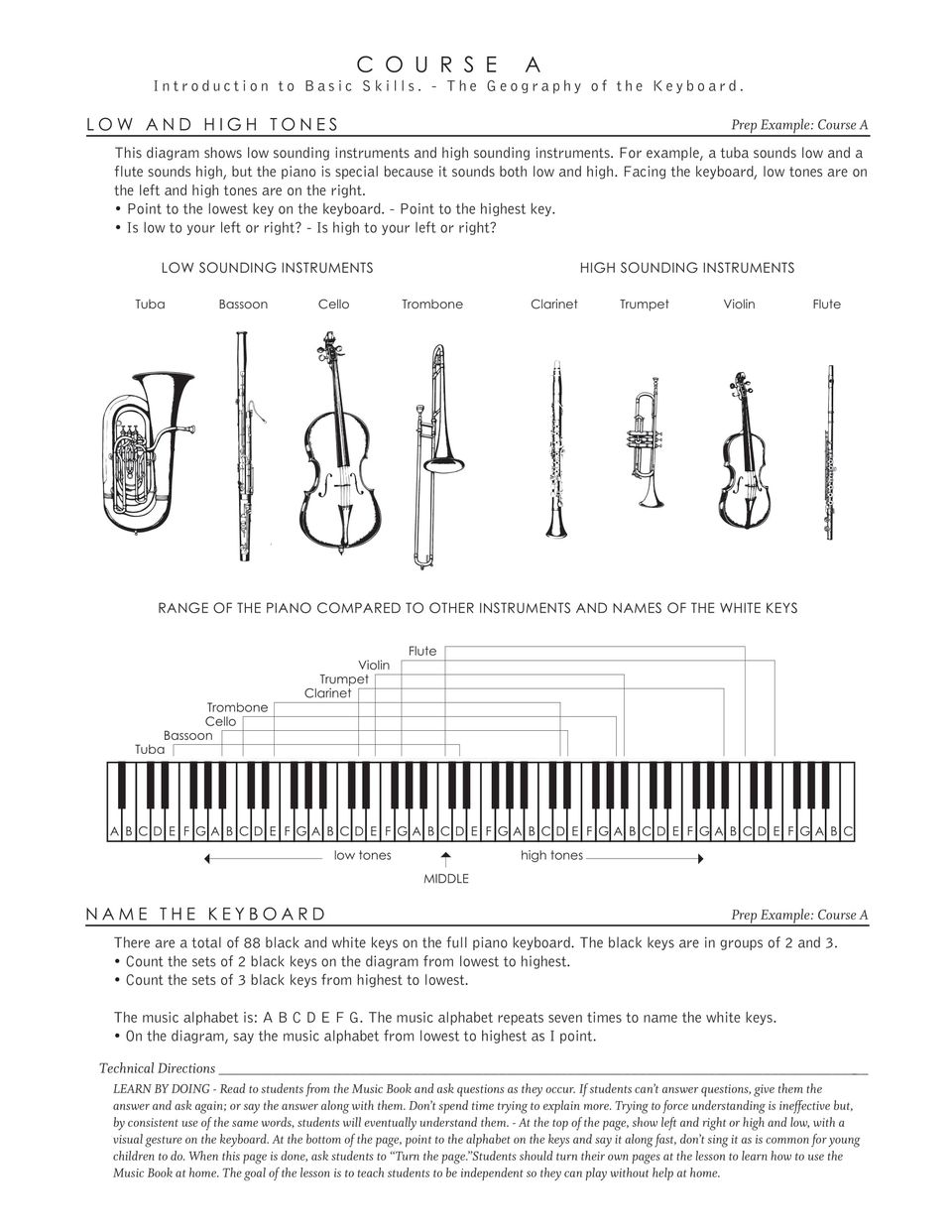PAGE 1

INSTRUMENTS
Look at the diagram of the various kinds of instruments. This diagram is used at the lesson to teach low and high, but it can be expanded by any teacher or parent to talk about the different sizes, range, and construction of different instruments. However, at the lesson, we only learn which ones are low sounding and which ones are high sounding, and that the piano is special because it can play both low and high. No other method of teaching piano compares other instruments and the piano in this way.
What can go wrong...
Showing the comparison of instruments is easy and fun for the first lesson. However, because it is not normally taught, even after years of lessons very few music students realize the large range of the piano as compared to other instruments. Also, many other music studios have gone to electronic keyboards to teach lessons. This is a big mistake and diminishes the value of piano lessons. At all our studios we use acoustical pianos will full size keyboards. Especially if you do not have a full size piano at home, young students feel unique and special sitting at, listening to, and learning how to control a big piano.
LOW AND HIGH ON THE KEYBOARD
Low and high on the keyboard: There is a purpose for everything we do. Facing the piano, low sounds are on the left and high sounds are on the right. At the lesson, students reach to find the lowest and highest keys on the piano. They respond correcting without more explanation because the visual suggestion from the diagram in their Music Book gives the correct answer by showing low sounding instruments on the left and high sounding on the right. Also, finding lowest and highest is an extreme contrast that is easy to identify.
What can go wrong...
Music teachers usually explain low and high by their sound. Or try to explain them too many ways at once; such as low on the keyboard, which played horizontally to the left, and at the same time low on the staff read vertically, up and down. While there are a few students who can make order out of disorder, most will be confused and need lengthy explanations for clarification. The solution is to teach one until familiar. . . And then the other. Another example, the visual in many music books shows high first, and on the left side of the diagram. This reverse order causes needless additional explanation by the teacher, who assumes it is inevitable that left and right is confusing for young students without considering it could be an error in the way they were taught.
LEFT AND RIGHT HANDS
At lessons, students learn that left is below middle C and right is above middle C. They are also reminded to use their left hand or their right hand several times during the lesson. A significant proportion of people struggle to think of which way is left and which way is right, even as adults. Left-right decisions involve (neurological) functions that we address every week at lessons. For our students left and right eventually becomes second nature. Everything we do at the lesson has a purpose. By continuous use at the lesson, the orientation of left and right is easily learned without lengthy explanation.
What can go wrong...
The teacher may spend time explaining left and right and even think that the student struggles with their left and right. We don't have this problem because left and right is used at every lesson and students eventually learn left and right by their frequent use. Teachers who try "easy" ways to teach left and right actually confuse the student with too much information and prevent the natural orientation that made just by playing the piano.
THE ALPHABET
Students learn to say the music alphabet A B C D E F G which repeats seven times to name all the white keys on the piano. Young children probably already know the alphabet by singing. But, singing the alphabet does not leave a permanent imprint on the brain as proven by children who can sing the alphabet with confidence, but slow way down and change to a completely different demeanor to say the alphabet without singing. Right from the start, on the first lesson, our students learn to say the alphabet.
What can go wrong...
There is a purpose to everything we do. Most methods for beginners don't show the entire keyboard so students have no concept of how the keys repeat. For this reason, when they say G, they will want to say H and need correction saying, "Remember in the music alphabet A comes after G." We never have this problem because at our first lesson students repeat the music alphabet A through G seven times up the keyboard without saying H and; as a result, they will not make this common mistake.